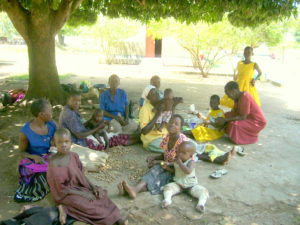By Dr. Andy Haig
October 15, 2018

At Kumi Hospital and many other Ugandan healthcare facilities, food is not provided for patients, so families often live on the grounds and cook meals for their loved ones during the hospital stay. Haig Consulting is working to help improve conditions in emerging economies.
Most people don’t think of Uganda other than as just another country in Africa. But when they hear that it’s a testbed for medical innovations, they begin to take notice. This recent report from NTV-Uganda indicates that the time is ripe for new ways to look for answers.
A few years ago, I visited Uganda with economist Paul Clyde, director of the William Davidson Institute at the University of Michigan and perhaps one of the world’s top experts on using business models to reach out to low- and middle-income countries.
We evaluated the possibility of physical rehabilitation as a way for hospitals to pay their bills. Sure enough, there is so little rehabilitation in Africa that a hospital which offers fee-for-service rehabilitation will have enough draw from upper and middle-income people to have money left over to deliver babies, save trauma victims and do their other critical tasks.
Paul has continued to figure out the models of sustainability by working with engineers, physicians, administrators all over the world, and describing innovations that tap what our sorely missed colleague C.K. Prahalad called in his famous book, ‘The Fortune at the Bottom of the Pyramid‘.
Building Healthcare in Low/Middle-Income Countries
In honor of the Davidson Institute’s 25th anniversary, Paul asked me to help write and edit a monograph on what we know about building sustainable healthcare in low or middle income countries, 25 Years of Health Care Delivery in Low- and Middle-Income Countries.
At the time, I was the University of Michigan’s director of telemedicine for its 2,000 physician, 38 department healthcare organization. My contribution to the report is about how telemedicine can be sustained in both low-resource and industrialized countries.
The paper served “as a primer for anyone interested in understanding health care delivery in emerging markets.” We noted a few examples from low-income countries that are having an impact in high-income countries:
• Operational efficiencies such as high-volume surgical operations at Aravind Eye Care and Narayana Health in India illustrate the potential of improving the use of human and physical capital.
• Technical efficiencies such as Becton Dickinson’s Odon Device, GE’s electrocardiogram or many of those developed in universities are designed specifically for low-resource settings.
• New techniques such as the hydrocephalus surgical procedure developed at CURE in Uganda are developed because there isn’t an alternative.
The conclusion: Low-resource settings are likely to be fertile ground for innovations both because they don’t have other options and because they don’t have existing infrastructure, products or processes to get in the way.
Putting Research Into Action
Now as I lead Haig Consulting, I’m looking forward to using this expertise to help industrialized healthcare systems build telemedicine and telerehabilitation solutions. Our work with low-resource countries, through the International Rehabilitation Forum, is extensively putting the work Paul and I write about into practice, too. Please let us know if we can help you or others build financially sustainable telemedicine or rehabilitation solutions.
Clyde P, Haig A, Jhaveri E, Karazja M,Leroueil PR, Ranganathan K, Sienko KH, Song S, Srinavasan A, Waiswa P, William Davidson Institute, the University of Michigan, 2018. At: https://wdi.umich.edu/wp-content/uploads/WDI-25-Years-of-Health-Care-Delivery-in-Low-and-Middle-Income-Countries-WEB.pdf.
